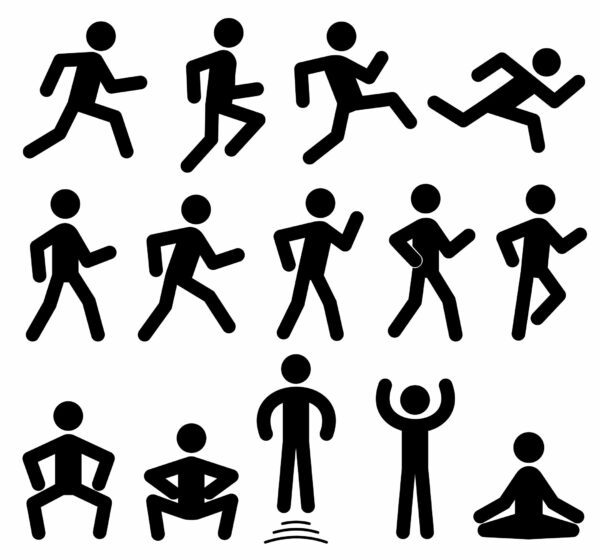
During the COVID-19 pandemic, activity levels dropped for a lot of people. Between stay-at-home orders, gym closures and working from home, people became more sedentary. On top of that, there were shortages of equipment like dumbbells and bicycles, making staying active at home difficult even if you wanted to.
But right now, things look different; vaccines are widely available, restrictions are loosening and people are looking to get active and enjoy the activities they love again. That’s all good news, but if you had a long break from activity, your body might not be ready to jump right back in.
Here are a few tips to help you get more active without getting hurt.
Start Slow
- If you’re a runner, think about a walk-to-run program
- If you’re a weight lifter, start with lighter weights and fewer reps.
- Whatever your activity of choice is, start with short periods of activity and gradually work your way back up.
- Consider working with a Physical Therapist to evaluate your current status, or your Movement Baseline, and develop a return-to-activity plan specific to your body and your goals. All of this can be provided through a Functional Movement Screen.

Warm-up and Cool Down
Warming up gets your heart and lungs ramped up and prepares your muscles and tendons for the increase in activity about to come. Include some light cardio like jogging, calisthenics, or cycling, followed by active stretching like butt kicks, high knees, or yoga.
Cooling down transitions your body back to a lower state of stress – it brings your heart rate and breathing down, decreases blood flow to your muscles and back to places like your digestive system, and helps you relax. It’s also a great place for static stretches if you need some work on your flexibility.
Take a Day Off!
Rest days let your body recover and keep you from getting burned out. Not enough exercise isn’t good for you, but too much of a good thing can cause problems too. Be sure to get an adequate number of hours of good quality sleep, not only on rest days but on work-out days as well.
Watch for Early Signs of Injury
Some soreness for a few days after the activity is normal, especially if you’ve had a long break. But there are a few common issues to watch out for as you return to activity:
- Swelling or bruising
- Joint pain, especially in the knees or shoulders
- Foot pain, which could be a sign of plantar fasciitis
- Muscle strains – particularly common in the hamstrings
- Sprains – most common in the ankle
Any of these issues justifies a call to your physical therapist. Getting checked out early can prevent an injury that derails your attempt to return to activity. PTs see all of the issues just mentioned on a regular basis and can help safely guide you back into a more active lifestyle.
Thank you to the APTA Private Practice Section for providing the content for this blog.
Keep Reading…
What is a Physical Therapist Qualified to Treat?
Like most professions, physical therapy continues to evolve as a profession. It is now a 6 year doctorate program. Within that time, we learn to treat people with orthopedic conditions, neurological impairments, cardiac issues, amputations, vestibular issues and more. Physical therapists are trained to work with newborns to geriatrics and everyone in between. After graduation, we have to pass a national test to become licensed to practice. To keep our license active, we have to complete 36 hours of education every 3 years. This is where we can choose courses to better ourselves in our specific setting and learn the most modern techniques! Below is a general (but not inclusive) list of conditions we treat in outpatient physical therapy:
Why Do I feel Like I’m Spinning?
BPPV, or Benign Paroxysmal Positional Vertigo, is a common cause of vertigo, or a false sense of spinning. It is fairly common among adults, with increased incidence as you age. It usually comes on without an apparent reason, however can occur after a head trauma or after spending time in a head tipped back position (such as in a dentist chair). Usually you will first notice symptoms when turning over in bed or when sitting up from bed in the morning.
The spinning sensation occurs due to a mechanical problem in the peripheral vestibular system of the inner ear. This system has calcium crystals called otoconia that sit on a gel-like substance and are sensitive to gravity, as well as three semicircular canals filled with fluid that are oriented in three different planes. In a normal vestibular system, the fluid in the canals moves when your head moves. This displaces hair cells and sends a message to the brain to tell it that your head is moving. Sometimes the otoconia crystals become dislodged into the fluid and give your brain a false signal that your head is moving when it’s not. This results in a spinning sensation, or vertigo.
Why am I having knee pain?
Injuries can happen any time during your training process, it is important to understand the difference between a “good pain” and a “bad pain”. At Onondaga Physical Therapy we offer Free Injury Screens as well as full evaluations to help quickly diagnose your issue, and help you on the road to recovery.
Knee injuries are very common among active individuals and best treated as soon as the pain starts – waiting typically lengthens the rehab time.
- Causes: Poor stability above or below the knee, poor or old footwear, sedentary lifestyle, poor mechanics, too much training of the “same muscles” without cross-training
Low Back Pain During Pregnancy
Prevelance:
It is estimated that approximately 50% of pregnant women will experience some kind of low back pain during their pregnancy, or during the postpartum period. Of those that experience low back pain, only about 50% of them will seek advice from a healthcare professional; with only 70% of those women actually receiving treatment.
Causes:
- Mechanical: Weight gain during pregnancy, increased abdominal size, shifting of the center of mass forward; all can increase the stress on the low back. When the abdominal muscles stretch to accommodate the growing uterus, muscle fatigue typically occurs which results in an increased load on the spine. Another common finding is weakness of their gluteus medius, or the outer glute/hip muscle.
- Hormonal: Relaxin is a hormone secreted during pregnancy, and it causes your ligaments to get lax, which in turn can cause your pelvis to become unstable. This includes not only the SIJ (sacroiliac joint), but the entire low back resulting in instability of the pelvis and poor alignment of the spine.
Symptoms:
Physical Therapist Expands Knowledge for Treatment of Dizziness
On January 25th, 2017 physical therapist Julie Dmochowski, PT, DPT of Onondaga Physical Therapy attended a full-day seminar in Syracuse, NY titled: The Hands-on Guide to Vestibular Rehabilitation: Clinical Decision Making to Treat Vertigo, Dizziness, and Balance Disorders. The course consisted of over 7 hours of content and hands-on application of skills in order to most effectively evaluate and manage the dizzy patient.
How can the rotator cuff help my shoulder pain
Gym Injuries can happen any time during your training process and it is important to understand the difference between a “good pain” and a “bad pain.” At Onondaga Physical Therapy we offer Free Injury Screens for a quick diagnosis of your issue, and help you on the road to recovery.







